Define an experience
Strategy Rules provides several experiences based on a viewer's Visit Condition:
Each experience is explained in the following sections.
Content Experience
A content experience allows you to configure player options, customize player appearance, and select content to be displayed to the visitor.
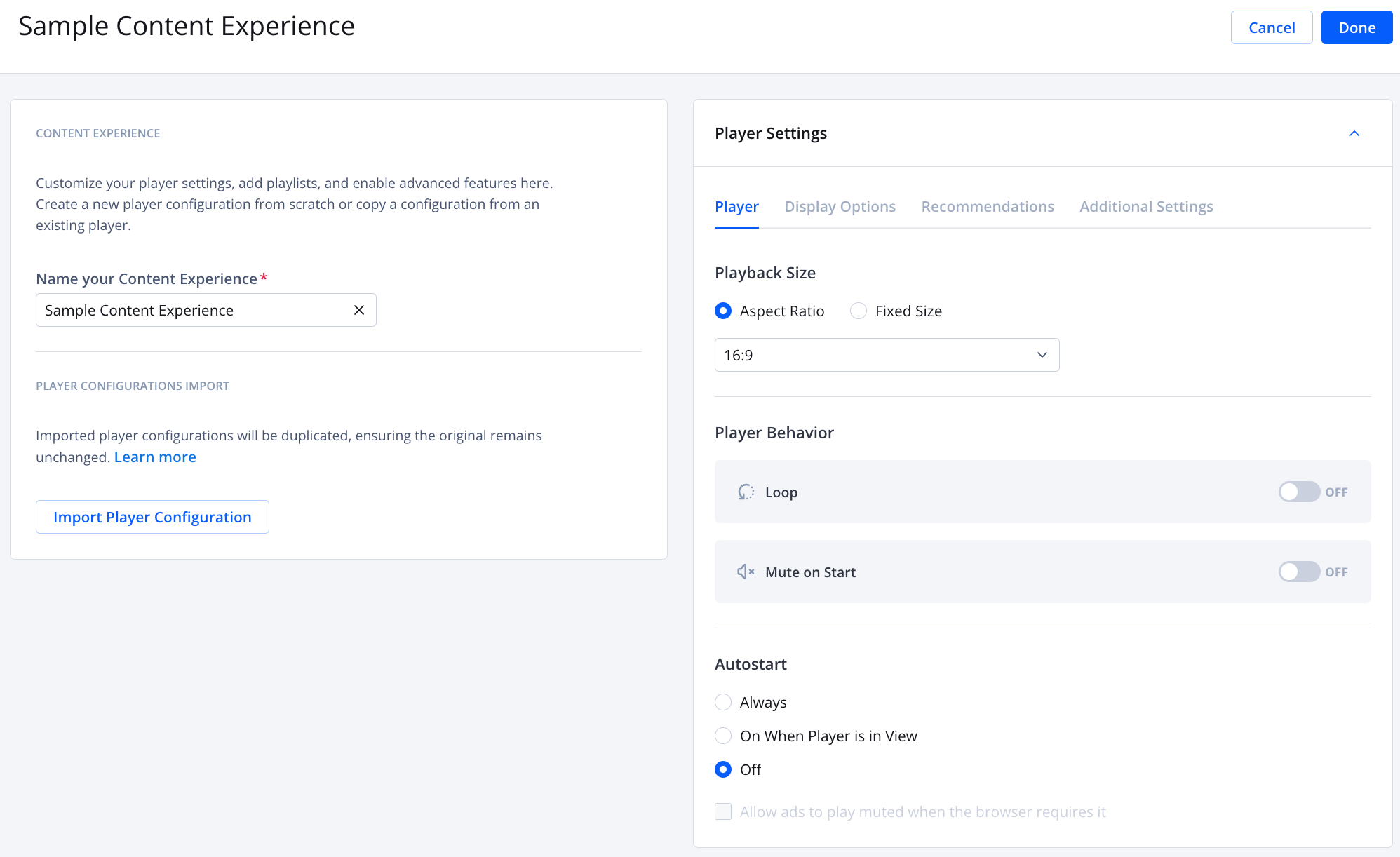
Content Experience details page
Use the following steps to create a content experience:
- On the strategy tree, click +Add Experience > Content Experience. The content experience details page appears.
- Under Content Experience, enter a name in the Name your Experience field.
- (Optional) Expand the Player Settings section and configure the settings on the four tabs:
- Player
- Display Options
- Recommendations (Steps 4-9)
- Additional Settings
As an alternative, you can copy the settings of an existing player:
- Under Player Configurations Import, click Import Player Configuration. The Import Player Configurations panel appears.
- Select the player configuration to import.
- Click Import. The settings of the player populate the tabs of the Player Settings section.
If you make changes to the existing player in the future that you want reflected in the strategy, you must repeat the previous steps.
- Expand the Playlist Settings section.
- Use the following table to define the playlist settings.
- Click Done. The experience appears on the decision tree.
- Click Save.
Advertising Experience
An advertising experience allows you to define video advertising settings, set up ad breaks, and enable Player Bidding.

Advertising Experience details page
Use the following steps to create an advertising experience:
-
On the strategy tree, click +Add Experience > Advertising Experience. The advertising experience details page appears.
-
Under Create Advertising Experience, enter a name in the Name your Experience field.
-
(Optional) On the right side of the page, define the advertising experience:
As an alternative, you can copy the settings of an existing ad schedule:
- Under Ad Schedule Import, click Import Ad Schedule. The Import Advertising Schedule panel appears.
- Select the ad schedule to import.
- Click Import. The settings of the ad schedule will be used to populate all the advertising experience sections on the right side of the page.
If you make changes to the existing ad schedule in the future that you want reflected in the strategy, you must repeat the previous steps.
- (Optional) Click the Google Publisher Provided Signals toggle to ON.
Google Publisher Provided Signals* allows automatically passing IAB contextual segments through the ad tag to improve programmatic monetization.
When using this feature, note the following:
- JWP will attempt to contextualize videos, but not all videos will have the IAB contextual segments passed through Google PPS.
- If the
&ppsjquery parameter is defined in the ad tag, JWP will not override the value.
* Google Publisher Provided Signals needs to be enabled by JWP. Contact your JWP account representative to opt in.
- (Optional) Click the Player Bidding toggle to enable and configure Player Bidding. Use only steps 4-12 of Create a Player Bidding template to configure this section.
- Click Done. The experience appears on the decision tree.
- Click Save.
Hide Player
This experience hides the video player from the visitor.
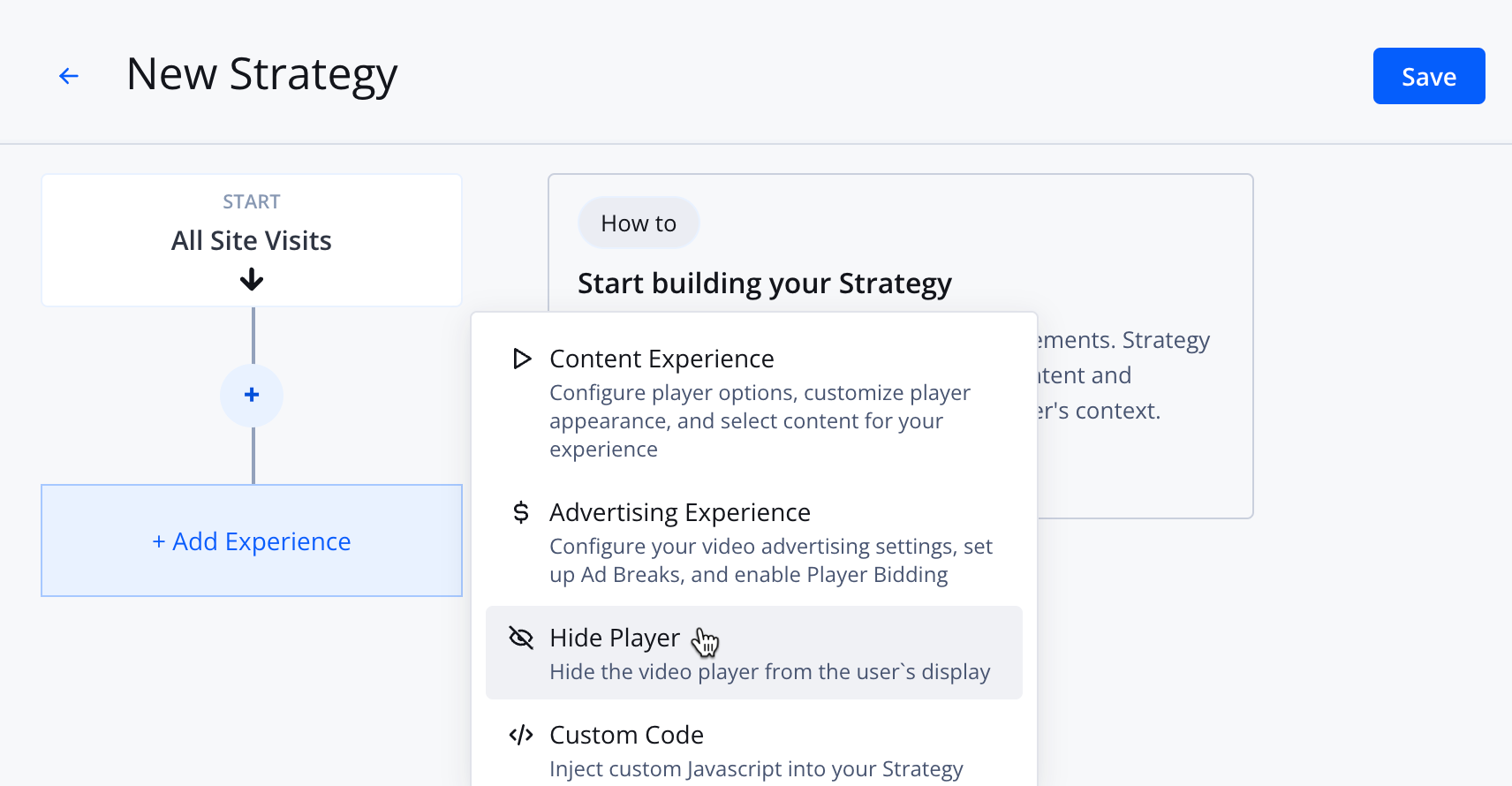
Hide Player experience selection
Use the following steps to create this experience:
- On the strategy tree, click +Add Experience > Hide Player. The experience appears on the decision tree.
- Click Save.
Custom Code
Custom code allows you to inject custom JavaScript code into your strategy.
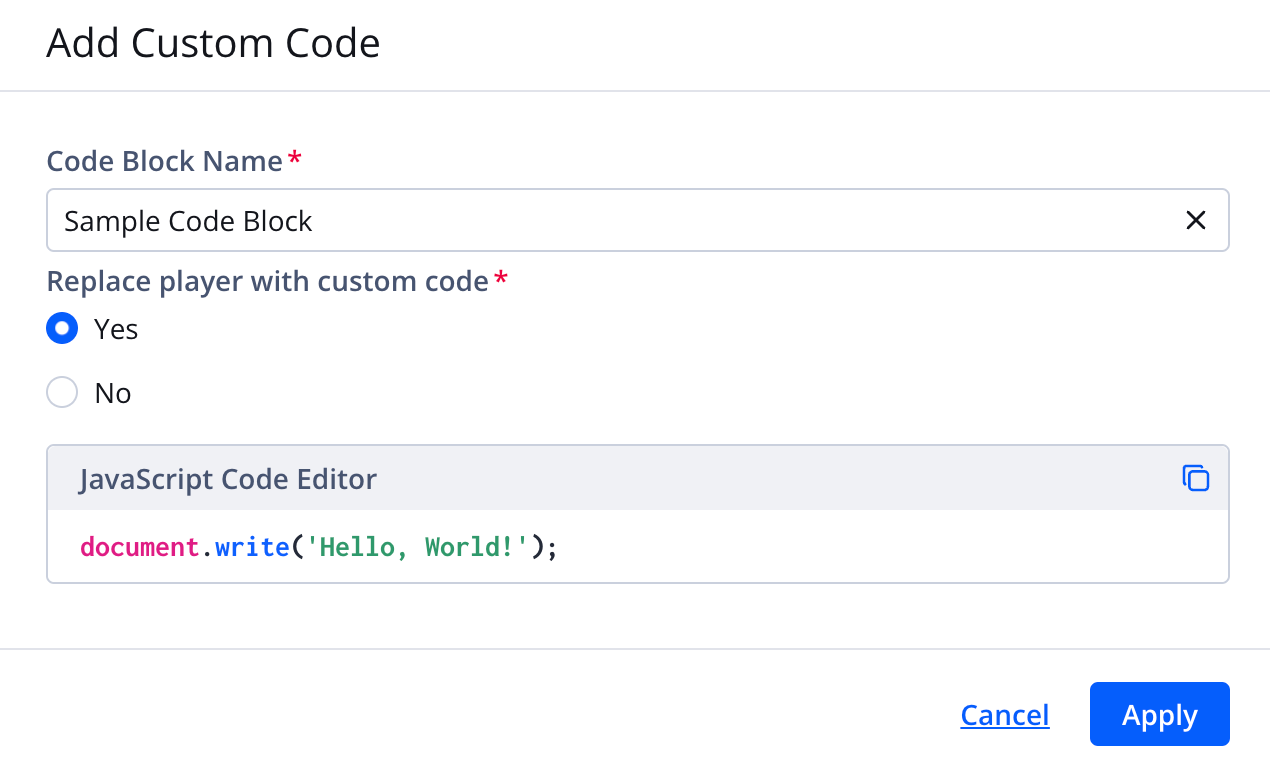
Add Custom Code panel
Use the following steps to add custom code:
- On the strategy tree, click +Add Experience > Add Custom Code panel opens.
- Enter a Code Block Name.
- Choose whether your custom code will replace the player:
- Yes: The custom code will replace the player.
- No: The custom code will execute before the player.
- In the JavaScript Code Editor field, enter the code to execute.
- Click Apply. The custom code appears on the decision tree.
Trigger
A trigger allows you to define event rules that initiate actions.
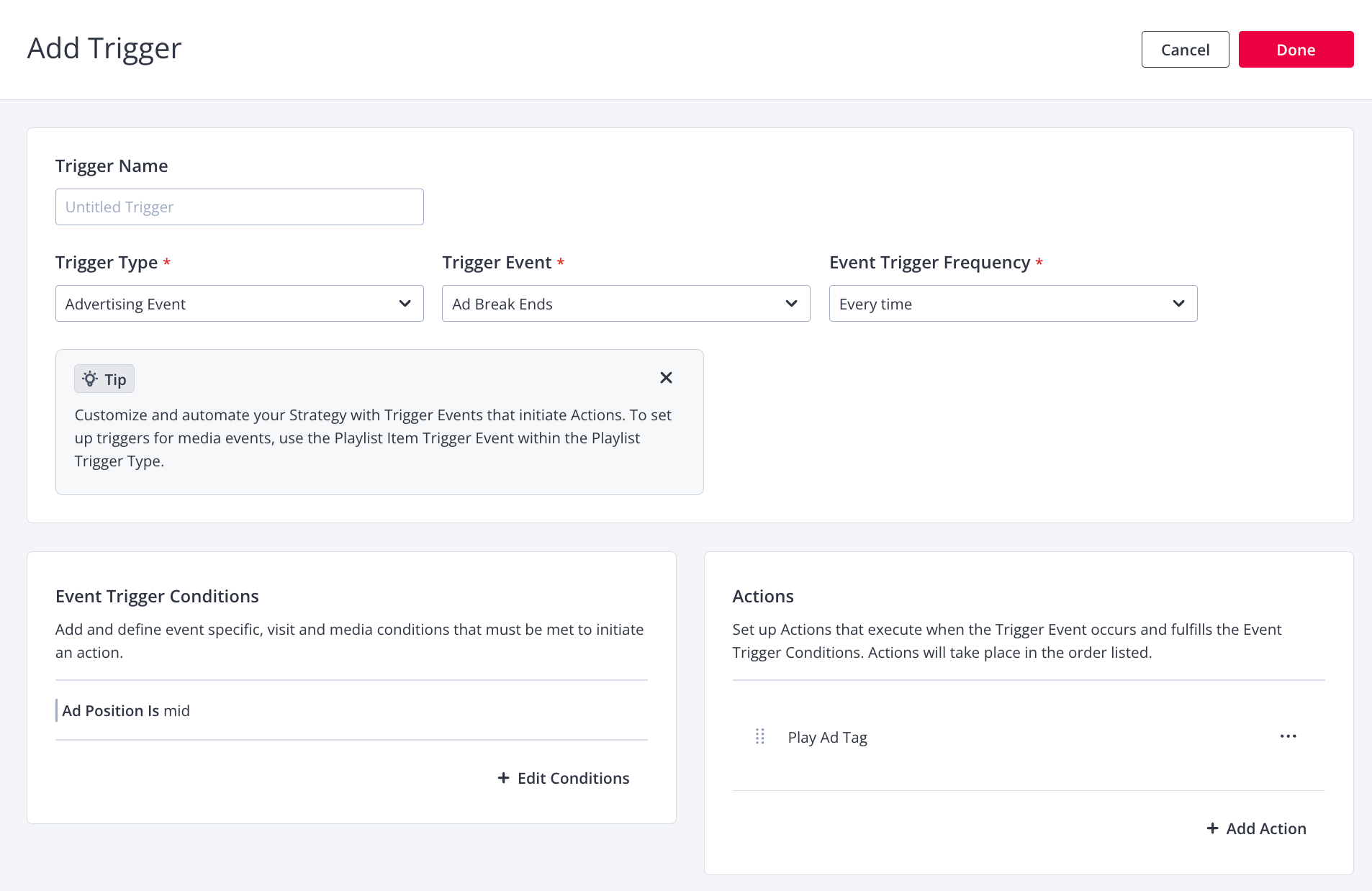
Use the following steps to create a trigger:
- On the strategy tree, click +Add Experience > Trigger. The Add Trigger page appears.
- Enter a Trigger Name.
- Select a Trigger Type.
- Select a Trigger Event.
To learn more about a specific event and the properties returned when fired, refer to the following pages:
- Advertising Events
- Player/Playback Events
- Playlist Events
- Select the Event Trigger Frequency.
Optional Description Every time Executes each time the event fires First time Executes on the first occurrence the event fires
The first occurrence can occur when a new viewer session starts or the viewer's browser cache has been cleared.Number of Occurrences Executes on the first occurrence the event fires
JWP restarts counting the number of occurrences when a new viewer session starts or the viewer's browser cache has been cleared.
- (Optional) Define the Event Trigger Conditions that must be met to initiate an action.
- Define the Actions to execute when the Trigger Event occurs.
- Click Done. The trigger is added to the strategy tree.
Event Trigger Conditions
-
Under Event Trigger Conditions, click + Add Condition. The Event Trigger Condition panel opens.
-
Define an event trigger condition to include in the rule:
Event Specific
Condition Description Ad Break ID Unique ID for each ad break
Use the following steps to set this event trigger condition:- From the dropdown menu, choose the comparative logic.
- In the last field, enter a value.
Ad Client Ad client in use for the ad break
Use the following steps to set this event trigger condition:- From the first dropdown menu, choose the comparative logic.
- From the next dropdown menu, select an option.
Ad Error Code Use the following steps to set this event trigger condition: - From the dropdown menu, choose the comparative logic.
- In the last field, enter a value.
Ad Error Message Ad error message
Use the following steps to set this event trigger condition:- From the first dropdown menu, choose the comparative logic.
- From the next dropdown menu, select an option.
Ad ID From the ad XML, ad server’s unique identifier for the creative
Use the following steps to set this event trigger condition:- From the dropdown menu, choose the comparative logic.
- In the last field, enter a value.
Ad Play ID Unique ID for each ad
Use the following steps to set this event trigger condition:- From the dropdown menu, choose the comparative logic.
- In the last field, enter a value.
Ad Position Position of the ad
Use the following steps to set this event trigger condition:- From the first dropdown menu, choose the comparative logic.
- From the next dropdown menu, select an option.
Ad Schedule Ad break information
Use the following steps to set this event trigger condition:- From the dropdown menu, choose the comparative logic.
- In the last field, enter a value.
Ad Tag URL of the ad tag that just completed
Use the following steps to set this event trigger condition:- From the dropdown menu, choose the comparative logic.
- In the last field, enter an ad tag URL.
Click Through URL Redirect URL
Use the following steps to set this event trigger condition:- From the dropdown menu, choose the comparative logic.
- In the last field, enter a click-through URL.
Current Time Position of the stream before the player seeks in seconds
Use the following steps to set this event trigger condition:- From the dropdown menu, choose the comparative logic.
- In the last field, enter a value.
Duration Total length of the ad creative (advertising) or current playlist item (player/playback) in seconds
Use the following steps to set this event trigger condition:- From the dropdown menu, choose the comparative logic.
- In the last field, enter a value.
Error Code Identifier for the error
See Player Errors Reference for a list of possible errors and error codes.
Use the following steps to set this event trigger condition:- From the dropdown menu, choose the comparative logic.
- In the last field, enter a value.
Error Message Error message that describes why the player could not be set up
Use the following steps to set this event trigger condition:- From the dropdown menu, choose the comparative logic.
- In the last field, enter a message.
Height New height of the player
Use the following steps to set this event trigger condition:- From the dropdown menu, choose the comparative logic.
- In the last field, enter a value.
Index Index of the currently playing playlist item
Use the following steps to set this event trigger condition:- From the dropdown menu, choose the comparative logic.
- In the last field, enter a value.
Linear Whether the ad is linear (plays in sequence with the video content) or non-linear (appears as an overlay on the video)
Use the following steps to set this event trigger condition:- From the first dropdown menu, choose the comparative logic.
- From the next dropdown menu, select an option.
Media Custom Parameters User-generated name-value pairs
As examples, custom fields can be used when setting cue points or storing legacy media IDs.
Use the following steps to set this event trigger condition:- In the first field, enter the custom key.
- From the dropdown menu, choose the comparative logic.
- In the last field, enter a value.
Media ID Unique ID of a media item
Use the following steps to set this event trigger condition:- From the dropdown menu, choose the comparative logic.
- In the last field, enter a value.
Offset Number Position that has been requested for seeking (in seconds)
Use the following steps to set this event trigger condition:- From the dropdown menu, choose the comparative logic.
- In the last field, enter a value.
Old State Previous state of the player
Use the following steps to set this event trigger condition:- From the first dropdown menu, choose the comparative logic.
- From the next dropdown menu, select an option.
Pause Reason Reason ad playback has been paused
Use the following steps to set this event trigger condition:- From the first dropdown menu, choose the comparative logic.
- From the next dropdown menu, select an option.
Placement Value sent in a bid request that identifies the location of a player
Use the following steps to set this event trigger condition:- From the first dropdown menu, choose the comparative logic.
- From the next dropdown menu, select an option.
Placement Value sent in a bid request that identifies the location of a player
Use the following steps to set this event trigger condition:- From the first dropdown menu, choose the comparative logic.
- From the next dropdown menu, select an option.
Play Reason Reason for the play
Use the following steps to set this event trigger condition:- From the first dropdown menu, choose the comparative logic.
- From the next dropdown menu, select an option.
Player Old State State of the player prior to ad pause
Use the following steps to set this event trigger condition:- From the first dropdown menu, choose the comparative logic.
- From the next dropdown menu, select an option.
Position Playback position in seconds
Use the following steps to set this event trigger condition:- From the dropdown menu, choose the comparative logic.
- In the last field, enter a value.
Position Number Position of the player before it seeks, in seconds
Use the following steps to set this event trigger condition:- From the dropdown menu, choose the comparative logic.
- In the last field, enter a value.
Response Code Use the following steps to set this event trigger condition: - From the dropdown menu, choose the comparative logic.
- In the last field, enter a value.
Setup Time Amount of time in milliseconds for the player to go from setup()to ready
Use the following steps to set this event trigger condition:- From the dropdown menu, choose the comparative logic.
- In the last field, enter a value.
Tags Single tag associated with the media item
Use the following steps to set this event trigger condition:- From the dropdown menu, choose the comparative logic.
- In the last field, enter a single tag.
This Waterfall Item Use the following steps to set this event trigger condition: - From the dropdown menu, choose the comparative logic.
- In the last field, enter a value.
Title Title of the media item
Use the following steps to set this event trigger condition:- From the dropdown menu, choose the comparative logic.
- In the last field, enter a value.
Total Waterfall Items Use the following steps to set this event trigger condition: - From the dropdown menu, choose the comparative logic.
- In the last field, enter a value.
Viewable If the player is viewable or not
The player is viewable when it is at least 50% in view and in the active tab. The player is not viewable when it is below 50% in view or in an inactive tab.
Use the following steps to set this event trigger condition:- From the dropdown menu, choose the comparative logic.
- Click the True or False radio button to define the viewability value.
Width New width of the player
Use the following steps to set this event trigger condition:- From the dropdown menu, choose the comparative logic.
- In the last field, enter a value.
Geography
JWP gathers geographical data by analyzing a viewer's internet connection through its Global Content Delivery Network (CDN). This method is not always accurate.
The precision of location data can vary depending on the internet connection’s characteristics. Inaccurate location may occur during the following cases:
- VPNs. If a viewer employs a VPN, JWP’s CDN will identify the location of the VPN server rather than the viewer’s actual geography.
- Mobile devices. As determined by a service provider’s traffic management, mobile internet users may appear in a general area rather than a precise location.
Type Description Country Follow the steps to set the visit condition: - From the first dropdown menu, select Country.
- From the next dropdown menu, select the inclusive or exclusive logic operator.
- From the final dropdown menu, select a country.
Region Larger economic or geographic area containing multiple countries, such as EMEA, EU, and LATAM
Follow the steps to set the visit condition:- From the first dropdown menu, select Region.
- From the next dropdown menu, select the inclusive or exclusive logic operator.
- From the final dropdown menu, select a region.
Subdivision Canadian province or US state
Follow the steps to set the visit condition:- From the first dropdown menu, select Subdivision.
- From the next dropdown menu, select the inclusive or exclusive logic operator.
- From the final dropdown menu, select a province or state.
Media
Condition Description Duration Total length of the item in seconds
Use the following steps to set this event trigger condition:- From the dropdown menu, choose the comparative logic.
- In the last field, enter a value.
ID Unique ID of a media item
Use the following steps to set this event trigger condition:- From the dropdown menu, choose the comparative logic.
- In the last field, enter a value.
Media Custom Parameters User-generated name-value pairs
As examples, custom fields can be used when setting cue points or storing legacy media IDs.
Use the following steps to set this event trigger condition:- In the first field, enter the custom key.
- From the dropdown menu, choose the comparative logic.
- In the last field, enter a value.
Tags Single tag associated with the media item
Use the following steps to set this event trigger condition:- From the dropdown menu, choose the comparative logic.
- In the last field, enter a single tag.
Title Title of the media item
Use the following steps to set this event trigger condition:- From the dropdown menu, choose the comparative logic.
- In the last field, enter a value.
Custom
Type Description Key Value Pair Custom data added for a specific placement
Follow the steps to set the visit condition:- From the first dropdown menu, select Key Value Pair.
- In the next text field, enter a key.
- From the next dropdown menu, select the logic operator.
- In the final text field, enter a value.
Device
Type Description Operating System Follow the steps to set the visit condition: - From the first dropdown menu, select Operating System.
- From the next dropdown menu, select the inclusive or exclusive logic operator.
- From the final dropdown menu, select the operating system.
Device Type Category of devices based on primary form factor and use case, such as desktop and phone
Follow the steps to set the visit condition:- From the first dropdown menu, select Device type.
- From the next dropdown menu, select the inclusive or exclusive logic operator.
- From the final dropdown menu, select the device type.
Local Date/Time
Type Description Day of Month Follow the steps to set the visit condition: - From the first dropdown menu, select Day of Month.
- From the next dropdown menu, select the logic operator.
- From the final dropdown menu, select a value.
Day of Week Follow the steps to set the visit condition: - From the first dropdown menu, select Day of Week.
- From the next dropdown menu, select the logic operator.
- From the final dropdown menu, select a day.
Hour Follow the steps to set the visit condition: - From the first dropdown menu, select Hour.
- From the next dropdown menu, select the logic operator.
- From the final dropdown menu, select an hour. Values are based on a 24-hour clock.
Local Date Follow the steps to set the visit condition: - From the first dropdown menu, select Local Date.
- From the next dropdown menu, select the logic operator.
- From the date picker, select a date.
Minute Follow the steps to set the visit condition: - From the first dropdown menu, select Minute.
- From the next dropdown menu, select the logic operator.
- From the final dropdown menu, select a minute value.
Month of Year Follow the steps to set the visit condition: - From the first dropdown menu, select Month of Year.
- From the next dropdown menu, select the logic operator.
- From the final dropdown menu, select a month.
Year Follow the steps to set the visit condition: - From the first dropdown menu, select Year.
- From the next dropdown menu, select the logic operator.
- From the text field, enter four-digit year.
UTC Date/Time
Type Description Day of Month Follow the steps to set the visit condition: - From the first dropdown menu, select Day of Month.
- From the next dropdown menu, select the logic operator.
- From the final dropdown menu, select a value.
Day of Week Follow the steps to set the visit condition: - From the first dropdown menu, select Day of Week.
- From the next dropdown menu, select the logic operator.
- From the final dropdown menu, select a day.
Hour Follow the steps to set the visit condition: - From the first dropdown menu, select Hour.
- From the next dropdown menu, select the logic operator.
- From the final dropdown menu, select an hour. Values are based on a 24-hour clock.
Local Date Follow the steps to set the visit condition: - From the first dropdown menu, select Local Date.
- From the next dropdown menu, select the logic operator.
- From the date picker, select a date.
Minute Follow the steps to set the visit condition: - From the first dropdown menu, select Minute.
- From the next dropdown menu, select the logic operator.
- From the final dropdown menu, select a minute value.
Month of Year Follow the steps to set the visit condition: - From the first dropdown menu, select Month of Year.
- From the next dropdown menu, select the logic operator.
- From the final dropdown menu, select a month.
UTC Date Follow the steps to set the visit condition: - From the first dropdown menu, select UTC Date.
- From the next dropdown menu, select the logic operator.
- From the date picker, select a date.
Year Follow the steps to set the visit condition: - From the first dropdown menu, select Year.
- From the next dropdown menu, select the logic operator.
- From the text field, enter four-digit year.
The available conditions will vary based on the chosen trigger event.
An event trigger condition can be comprised of multiple rules:
- To group a set of similar rules together, click + Add Rule and definite another event trigger condition. All rules are joined together using
ANDlogic exclusively, requiring all conditions to be satisfied together. - To create multiple groups of related rules, click + Add Group and define another event trigger condition. Multiple groups are joined together using
ORlogic exclusively, requiring the conditions of only one group to be satisfied.
-
Click Apply. The panel closes. The trigger condition appears in the Event Trigger Conditions section.
Actions
- Under Actions, click + Add Action. The Add Action panel opens.
- Select an Action Type.
- Select an Action. Depending on the selected action, one or several additional options may appear.
- If applicable, use the following table to define additional action settings:
Additional Action Settings
Setting Description Ad Tag URL URL of the ad tag to play
Follow this step to define this action:- In the field, enter the ad tag URL.
Code Editor XML ad code to execute
Follow this step to set this event trigger condition:- In the field, enter the code to execute.
Configure Ad Breaks Determines whether to remove ad breaks, customize ad breaks, or use a VMAP URL
Remove ad breaks
Follow this step to define this action:- Click the Remove ad breaks radio button.
Change ad breaks manually
Follow these steps to define this action:- Click the Change ad breaks manually radio button. The ad break settings appear.
- For the Preroll, Midroll, or Postroll, click + Add. The Ad Tag URL field appears.
- Enter the Ad Tag URL.
- (Midroll) From the Break Timing dropdown menu, select an option. Then, enter a number or timecode value.
VMAP
Follow this step to define this action:- Click the VMAP radio button. The Ad Tag URL field appears.
- Enter the Ad Tag URL.
Float Player Enables or disables floating player functionality
When enabled, the player is kept visible when the original player location is scrolled out of view by minimizing it to a corner of the screen.
Follow this step to define this action:- Click the toggle to ON to enable floating the player.
JavaScript Code Editor Custom code to execute
Follow this step to set this event trigger condition:- In the field, enter the JavaScript code to execute.
Jump to Location in the video to navigate to in hh:mm:ss.mmm format
Follow these steps to define this action:- Click on the hour portion of the time.
- Enter a number for the hour or click the tab key on your keyboard.
- Repeat step to enter the minutes, seconds, and milliseconds of the location.
Mute Player Silences content during playback
Follow this step to define this action:- Click the toggle to ON to mute the content.
Pause Enables or disables pause ad functionality
Follow this step to define this action:- Click the toggle to ON to pause the ad.
Type Type of content to load
Follow these steps to define this action:- Click the radio button next to Single Media or Playlist.
- From the dropdown menu, select the media or playlist.
Volume Sets the volume of the content during playback
Follow this step to define this action:- In the field enter a value between 0-100.
- Click Apply. The panel closes. The action is applied to the trigger.
- (Optional) Repeat the previous steps to add another action. When multiple actions are applied to a trigger, they are applied sequentially.
Traffic Split
A traffic split enables you to A/B test different strategy ideas by segmenting traffic into weighted branches. Viewers who return using the same device without deleting local cookies should have the same experience.
Additionally, traffic splits can be nested within other traffic splits.
Creating simple experiences within each branch of the traffic split enables you to more easily compare the effectiveness of each experience.
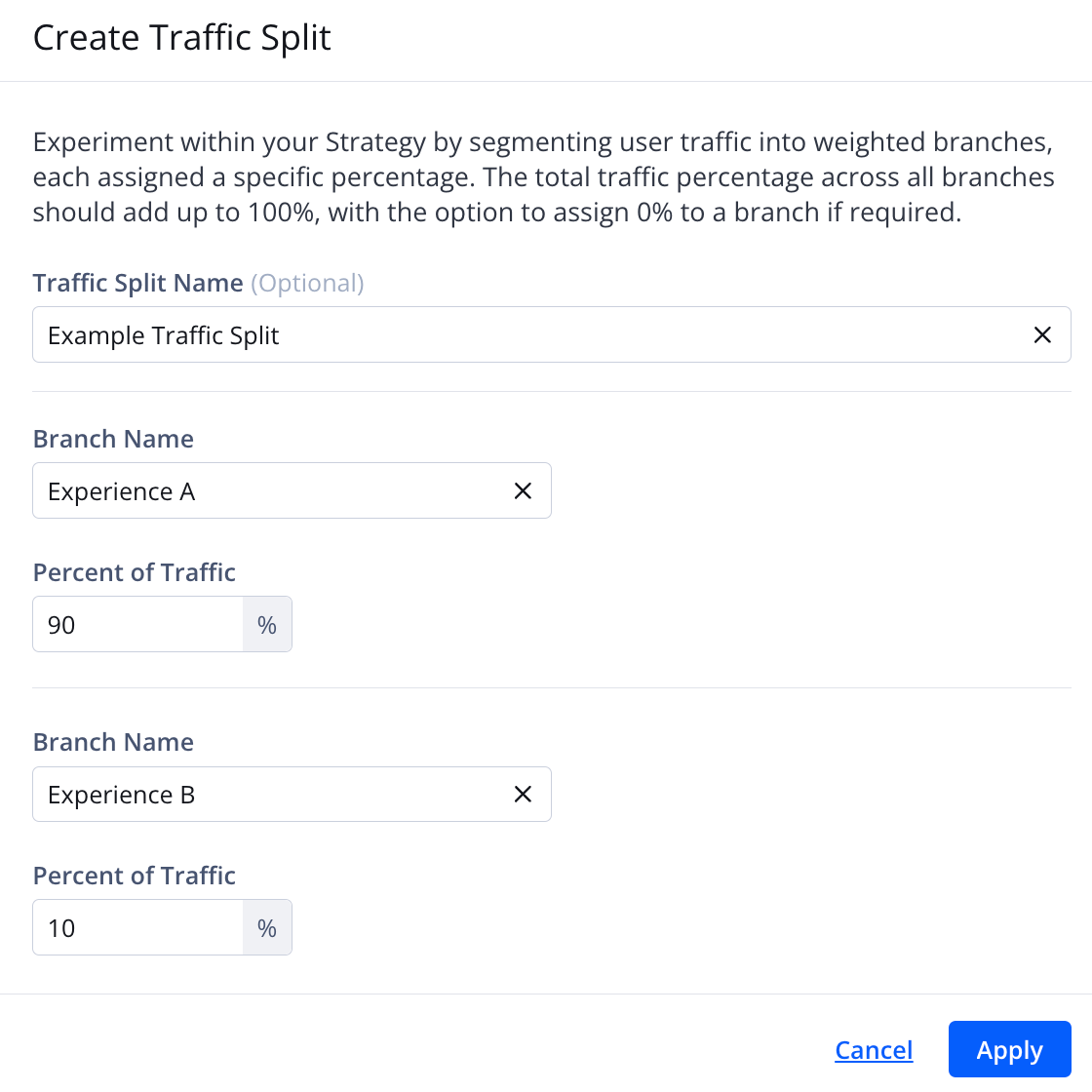
Create Traffic Split panel
Following these steps to create a traffic split:
- On the strategy tree, click + Add Experience > Traffic Split. The Create Traffic Split panel opens.
- Enter a Traffic Split Name.
- Enter a Branch Name for each branch.
- Enter the Percent of Traffic to route to a specific branch.
The Percent of Traffic only needs to be added to one branch. The UI will calculate the value of the other branch so that the combined total is 100%.
- Click Apply. The traffic split appears on the strategy tree.
- Click Save.
- Build each branch with experiences:
Updated 5 days ago
